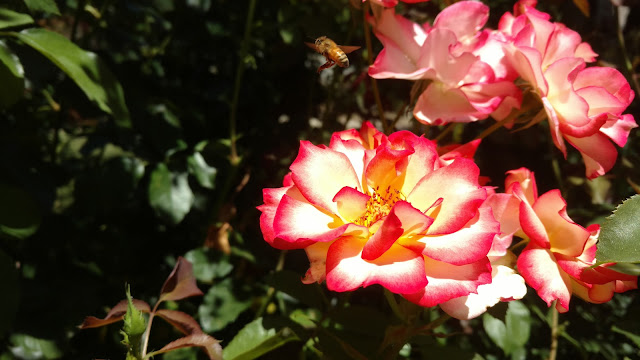
Free workshop shows how to attract more beneficial insects

|
| A honeybee is attracted to these Betty Boop roses. (Photo: Debbie Arrington) |
Want more buzz in your garden? Learn how to attract bees and other beneficial insects during a free virtual workshop, hosted by the UC Cooperative Extension Master Gardeners of Nevada County.
Set for 10 a.m. Saturday, Feb. 12, “Encouraging Beneficial Insects” is open to gardeners everywhere with no advance registration required. Just click the link and Zoom on in. Find it here: https://ncmg.ucanr.org .
Beneficial insects include a lot more bugs than honeybees.
“Pollinators are necessary for food and flower production,” say the master gardeners. “Parasitic insects are healthy alternatives to chemical pesticides. We’ll explain why these insects are desirable and what they need to flourish in your garden.
“We’ll list specific beneficial insects, and specific plants they love in Nevada County,” they add, “and teach you how to use online resources to find more insects and plants on your own.”
That plant list is applicable to most of the greater Sacramento region, too. Plant them and they will come!
Attracting beneficial insects to your great outdoors will make your landscape a much livelier place. Bees, butterflies, lady beetles, praying mantises, parasitoid wasps and more can help you be a better and more thoughtful gardener.
The Nevada County master gardeners hope to start holding in-person public workshops soon. In the meantime, Zoom workshops will continue as an alternative. Upcoming topics include: “Native Plants Bring Beauty and Benefits” (in two parts, Feb. 19 and 26); fire-wise landscaping (March 5); and “Functional Irrigation” (March 12). All workshops start at 10 a.m.
Details: https://ncmg.ucanr.org .
Comments
0 comments have been posted.Sacramento Digs Gardening to your inbox.
Sites We Like
Garden Checklist for week of Nov. 3
November still offers good weather for fall planting:
* If you haven't already, it's time to clean up the remains of summer. Pull faded annuals and vegetables. Prune dead or broken branches from trees.
* Now is the best time to plant most trees and shrubs. This gives them plenty of time for root development before spring growth. They also benefit from fall and winter rains.
* Set out cool-weather annuals such as pansies and snapdragons.
* Lettuce, cabbage and broccoli also can be planted now.
* Plant garlic and onions.
* Keep planting bulbs to spread out your spring bloom. Some possible suggestions: daffodils, crocuses, hyacinths, tulips, anemones and scillas.
* This is also a good time to seed wildflowers and plant such spring bloomers as sweet pea, sweet alyssum and bachelor buttons.
* Rake and compost leaves, but dispose of any diseased plant material. For example, if peach and nectarine trees showed signs of leaf curl this year, clean up under trees and dispose of those leaves instead of composting.
* Save dry stalks and seedpods from poppies and coneflowers for fall bouquets and holiday decorating.
* For holiday blooms indoors, plant paperwhite narcissus bulbs now. Fill a shallow bowl or dish with 2 inches of rocks or pebbles. Place bulbs in the dish with the root end nestled in the rocks. Add water until it just touches the bottom of the bulbs. Place the dish in a sunny window. Add water as needed.
* Give your azaleas, gardenias and camellias a boost with chelated iron.
* For larger blooms, pinch off some camellia buds.
* Prune non-flowering trees and shrubs while dormant.
* To help prevent leaf curl, apply a copper fungicide spray to peach and nectarine trees after they lose their leaves this month. Leaf curl, which shows up in the spring, is caused by a fungus that winters as spores on the limbs and around the tree in fallen leaves. Sprays are most effective now.